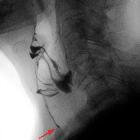Aspiration
















Aspiration occurs if liquid or solid material enters the subglottic lower respiratory tract.
Terminology
The term aspiration is used if material passes below the level of the vocal folds, i.e. subglottic. If material enters the larynx but remains above the vocal folds this is called penetration.
Pathology
The swallowing act is a well-coordinated and complex process, which once initiated is largely involuntary. The timely elevation of the hyoid and larynx as well as the posteroinferior tilt of the epiglottis ensure that the laryngeal aditus is closed as the bolus of food/drink passes.
Etiology
Aspiration usually happens during eating or drinking and may occasionally occur in healthy individuals (e.g. when simultaneously talking and eating) and should provoke a vigorous cough reflex. Numerous pathologies can cause laryngopharyngeal dysfunction that predisposes to recurrent aspirations:
- neurological insults (e.g. stroke, palsy of cranial nerves IX, X and XII or neurodegenerative diseases) can result in impaired coordination of deglutition
- alterations of normal anatomy (e.g. tumor, after operation or radiation) and impaired pharyngoesophageal clearance are predisposing factors
- unconscious patients are prone to aspiration of vomitus because of subdued/absent defensive reflexes
- foreign body aspiration: frequently happens in toddlers
- meconium aspiration: a complication in newborns
- tracheoesophageal fistula: rare cause of aspiration in infants
Radiographic features
Aspirated material and consequential lung pathology can be visualized with chest x-ray or CT. Videofluoroscopic swallow studies allow direct observation and analysis of the aspiration event.
Plain radiograph / CT
Findings are discussed in the article on pulmonary aspiration diseases.
Fluoroscopy
A videofluoroscopic swallow study can visualize the timing, mechanism and extent of aspiration.
- predeglutitive: aspiration occurs before the swallowing reflex is initiated
- lack of bolus control: dorsal leaking, delayed initiation of swallowing reflex
- intradeglutitive: aspiration occurs during the swallowing act
- insufficient larynx closure: reduced or delayed elevation of hyoid/larynx, incomplete epiglottic tilt, postoperative status, impaired pharyngeal clearance
- postdeglutitive: aspiration occurs after the main bolus has passed the pharynx
- associated with pharyngeal retentions
The severity of aspiration can be graded using the penetration-aspiration scale.
If a patient aspirates, one important factor is the presence of a sufficient cough reflex. The absence of an appropriate cough reflex (indicating "silent aspiration") may be associated with higher morbidity .
Choice of contrast medium
If a patient is at risk of aspiration the study should be performed with low osmolar water-soluble contrast medium (e.g. Omnipaque, Gastromiro). High osmolar contrast media (e.g. Gastrografin) are contraindicated due to the significant risk of flash pulmonary edema. Though aspiration of small amounts of barium sulfate contrast medium is generally not regarded harmful it can cause pulmonary baritosis and aspiration of larger amounts may lead to death.
Siehe auch:
- Postdeglutitive Aspiration
- Laryngeale Penetration
- Fremdkörperaspiration
- Intradeglutitive Aspiration
- Prädeglutitive Aspiration
- verzögerte Schluckreflextriggerung
- Aspirationsgrade nach Hannig
und weiter:

 Assoziationen und Differentialdiagnosen zu Aspiration:
Assoziationen und Differentialdiagnosen zu Aspiration:


